The document discusses a workshop organized by the DAPHNE project on evolutionary optimization algorithms and large-scale machine learning. It includes an agenda for a use case workshop on September 26th, 2023 in Graz, Austria. The document also provides background on differential evolution methods, including descriptions of the algorithm, control parameters, applications, and related work on improvements.
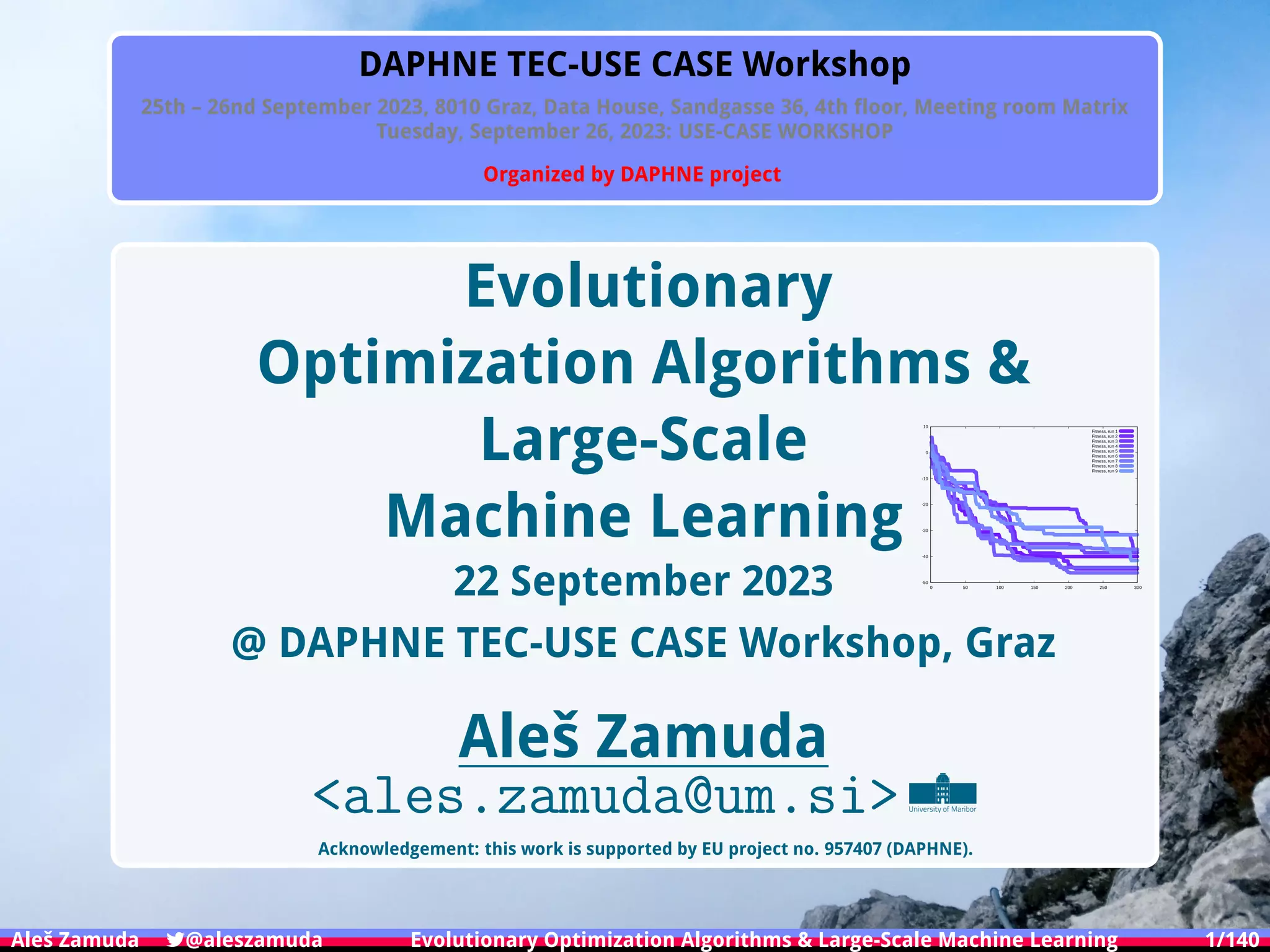
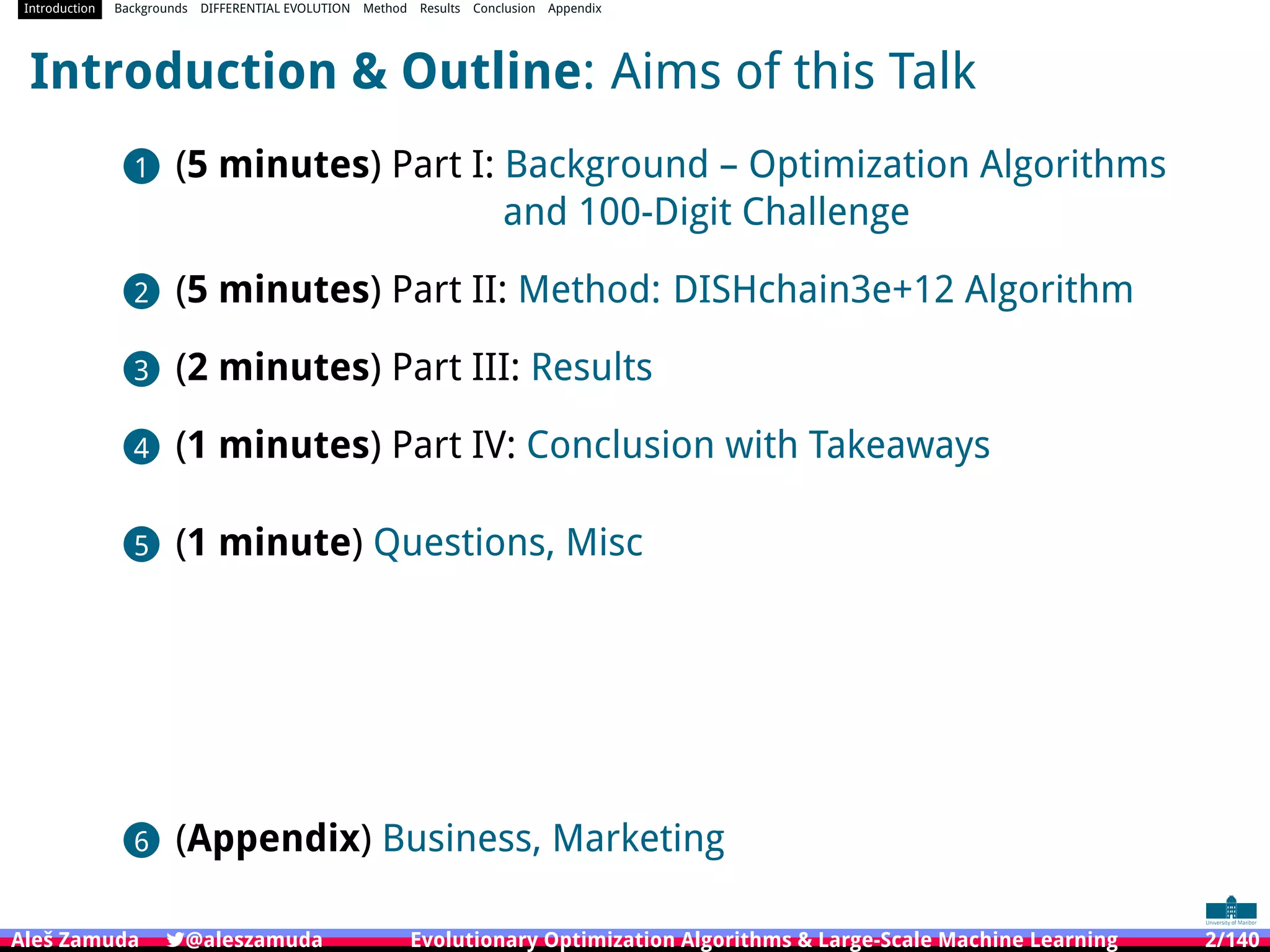
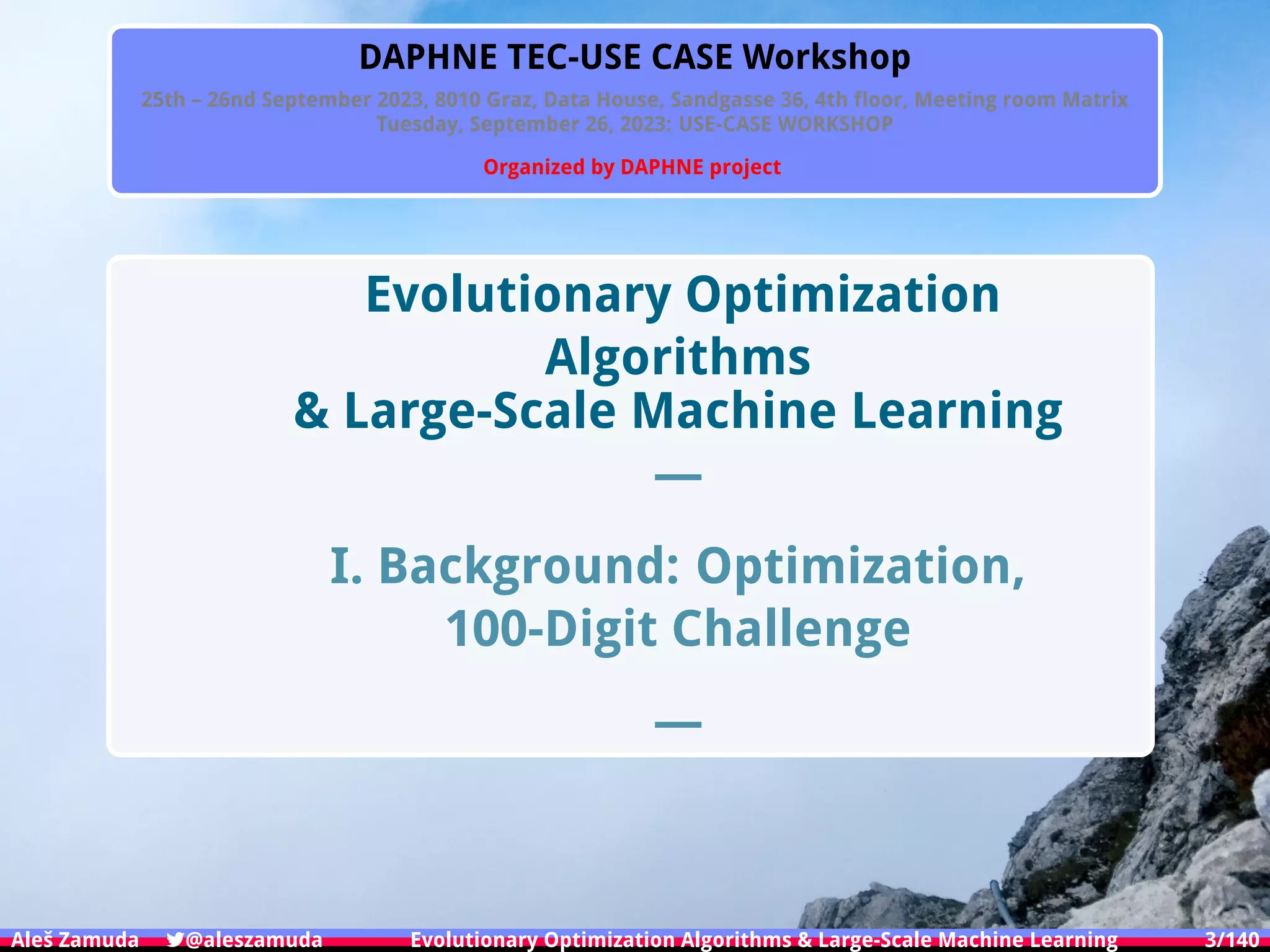

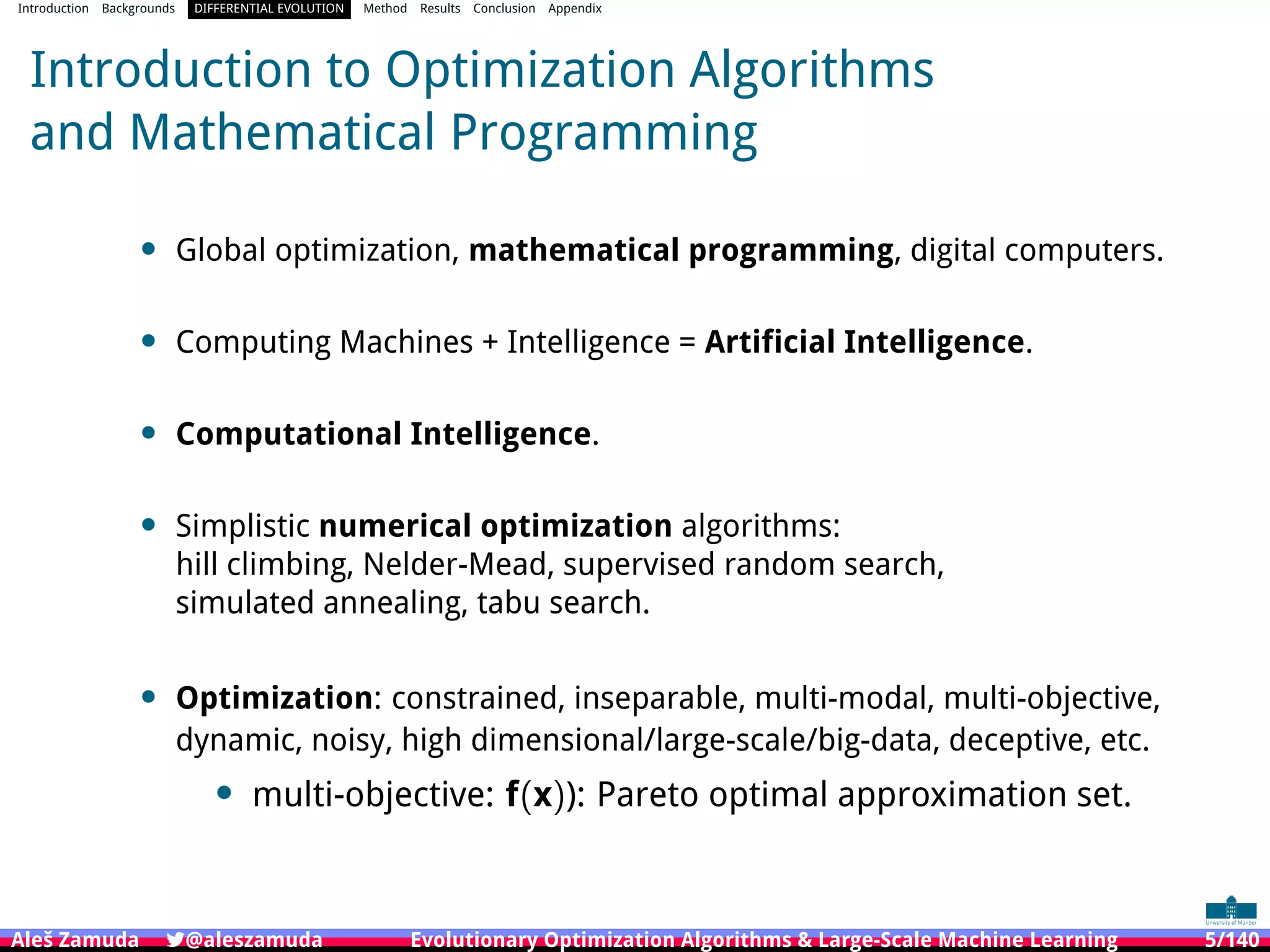
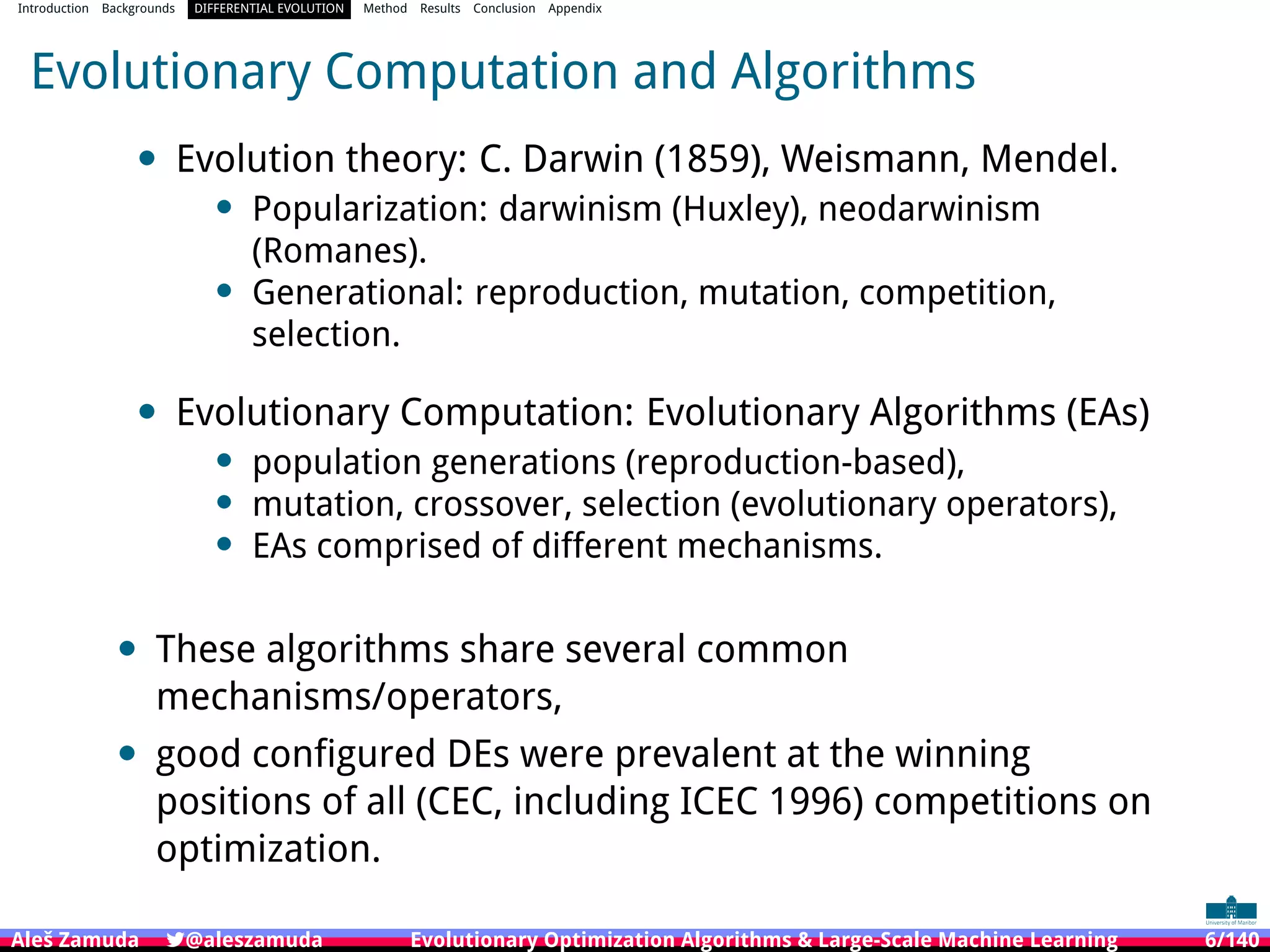
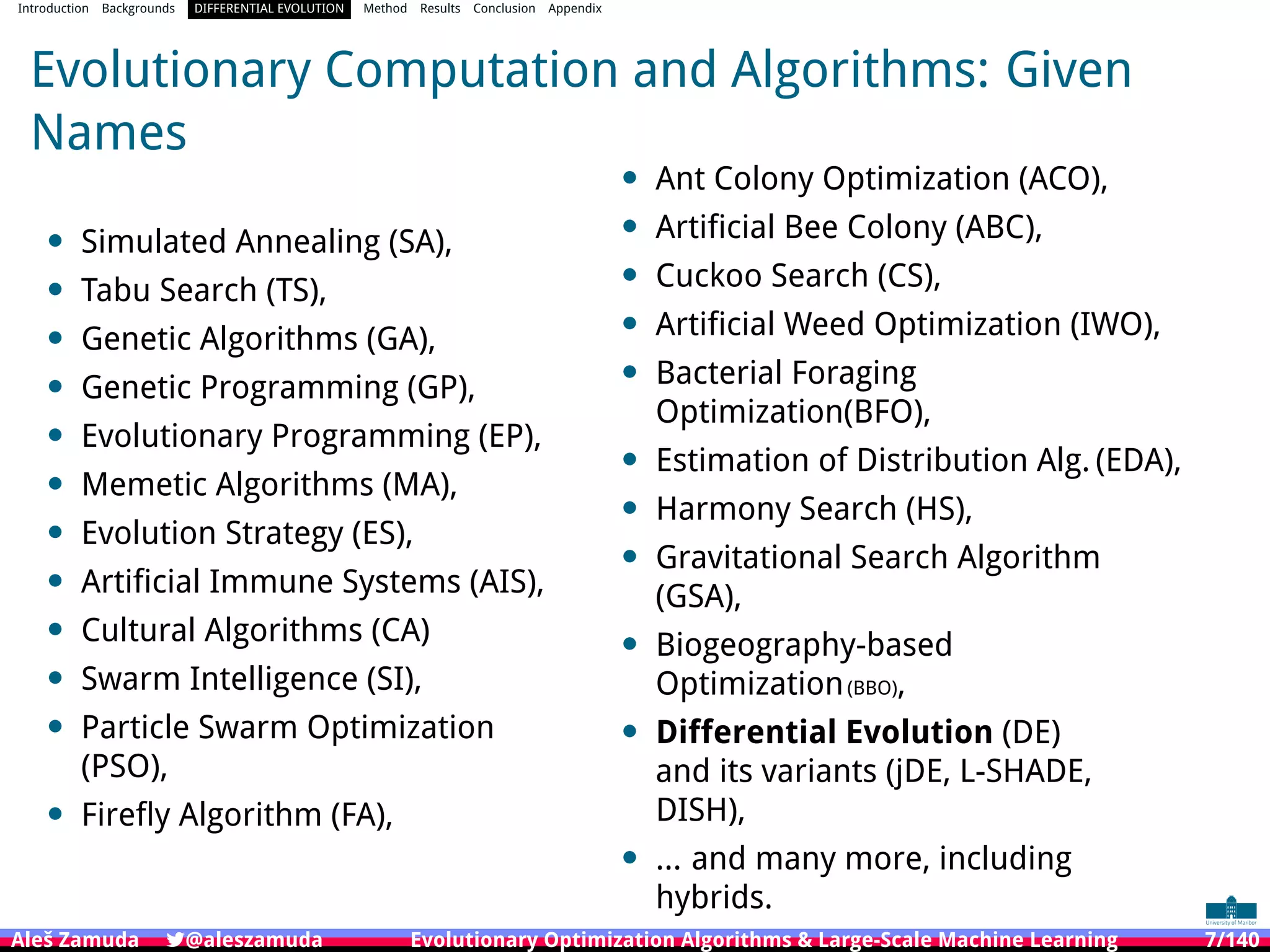









![Introduction Backgrounds DIFFERENTIAL EVOLUTION Method Results Conclusion Appendix
Functions of the Problems in 100-Digit Challenge
• The stated goal of the 100-Digit Challenge benchmark is:
• to understand better “the behavior of swarm and evolutionary algorithms
as single objective optimizers” (explainable AI)
• Continuous multi-dimensional (D) numerical functions, f(x)
• Solution quality is measured in number of precise digits (max. 10 per function)
• 10 digits added up per 10 functions = score of 100
No. Problem name X∗
D Search Range
1 Storn’s Chebyshev Polynomial Fitting Problem 1 9 [-8192,8192]
2 Inverse Hilbert Matrix Problem 1 16 [-16384,16384]
3 Lennard-Jones Minimum Energy Cluster 1 18 [-4,4]
4 Rastrigin’s Function 1 10 [-100,100]
5 Griewangk’s Function 1 10 [-100,100]
6 Weierstrass Function 1 10 [-100,100]
7 Modified Schwefel’s Function 1 10 [-100,100]
8 Expanded Schaffer’s F6 Function 1 10 [-100,100]
9 Happy Cat Function 1 10 [-100,100]
10 Ackley Function 1 10 [-100,100]
X∗
denotes an optimum (transformed to 1 for all functions).
Aleš Zamuda 7@aleszamuda Evolutionary Optimization Algorithms & Large-Scale Machine Learning 17/140](https://image.slidesharecdn.com/aleszamudaevolutionaryoptimizationalgorithmslarge-scalemachinelearningdaphnetec-usecaseworkshop26sep-230927134548-f9f6ce39/75/Evolutionary-Optimization-Algorithms-Large-Scale-Machine-Learning-17-2048.jpg)


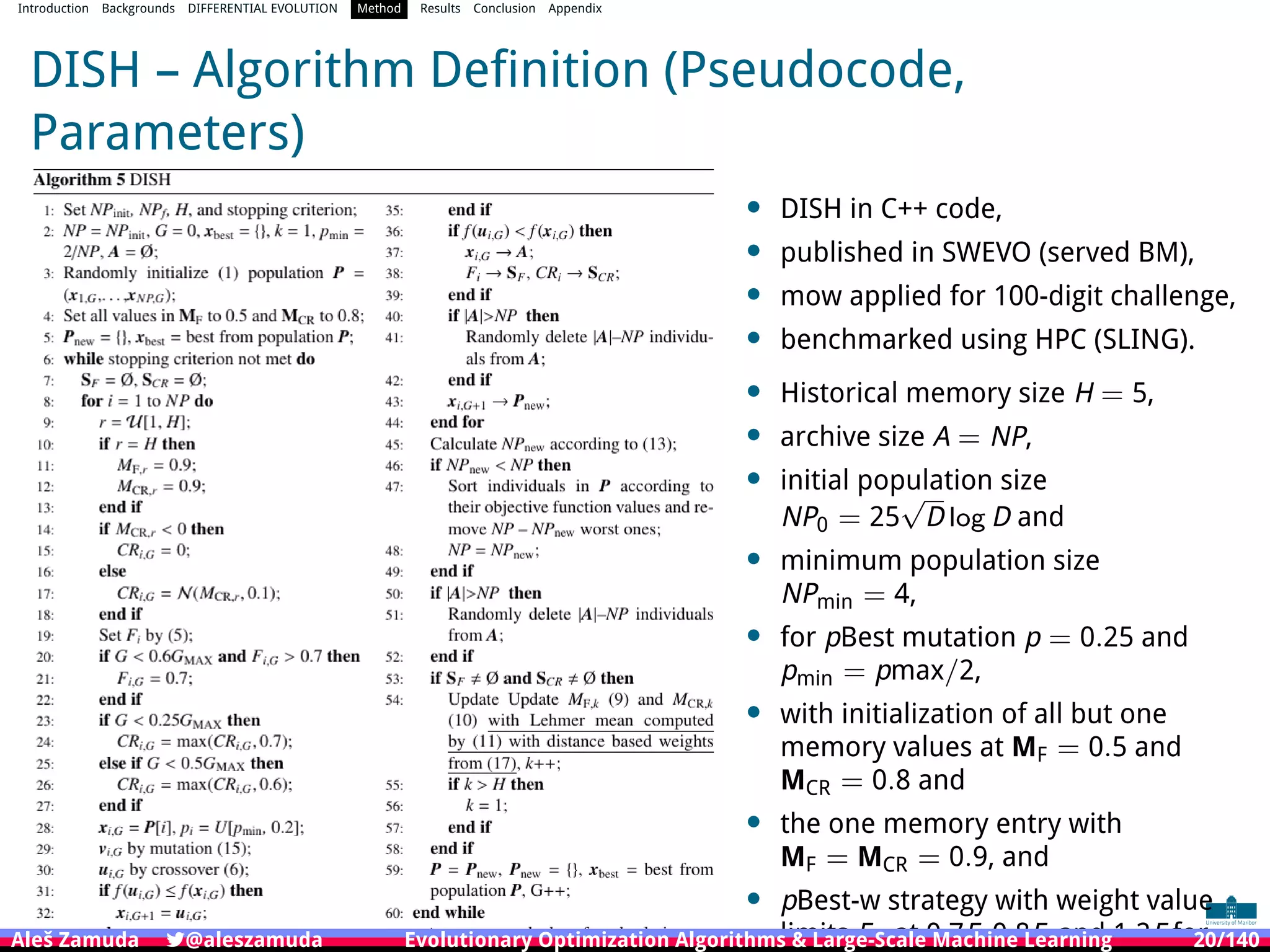
![Introduction Backgrounds DIFFERENTIAL EVOLUTION Method Results Conclusion Appendix
DISH – Algorithm Mechanisms Detailed
xj,i = U
h
lowerj, upperj
i
; ∀j = 1, . . . , D; ∀i = 1, . . . , NP, (1)
MCR,i = MF,i = 0.5; ∀i = 1, . . . , H, (2)
vi = xr1 + F (xr2 − xr3) , (3)
vi = xi + Fi
xpbest − xi
+ Fi (xr1 − xr2) , (4)
Fi = C
MF,r, 0.1
, (5)
uj,i =
vj,i if U [0, 1] ≤ CRi or j = jrand
xj,i otherwise
. (6)
CRi = N
h
MCR,r, 0.1
i
. (7)
xi,G+1 =
(
ui,G if f
ui,G
≤ f
xi,G
xi,G otherwise
, (8)
MF,k =
meanWL (SF) if SF ̸= ∅
MF,k otherwise
, (9)
MCR,k =
meanWL (SCR) if SCR ̸= ∅
MCR,k otherwise
, (10)
meanWL (S) =
P|S|
k=1
wk • S2
k
P|S|
k=1
wk • Sk
(11)
wk =
abs
f
uk,G
− f
xk,G
P|SCR|
m=1
abs
f
um,G
− f
xm,G
. (12)
NPnew = round
NPinit −
FES
MAXFES
∗ (NPinit − NPf)
,
(13)
p = pmin +
FES
MAXFES
(pmax − pmin). (14)
vi = xi + Fw(xpBest − xi) + F(xr1 − xr2), (15)
Fw =
0.7F, FES 0.2MAXFES,
0.8F, FES 0.4MAXFES,
1.2F, otherwise.
(16)
wk =
r
PD
j=1
uk,j,G − xk,j,G
2
P|SCR|
m=1
r
PD
j=1
um,j,G − xm,j,G
2
. (17)
Colors:
• black – L-SHADE base,
• gray – overloaded,
• blue – new w/ DISH.
Aleš Zamuda 7@aleszamuda Evolutionary Optimization Algorithms Large-Scale Machine Learning 21/140](https://image.slidesharecdn.com/aleszamudaevolutionaryoptimizationalgorithmslarge-scalemachinelearningdaphnetec-usecaseworkshop26sep-230927134548-f9f6ce39/75/Evolutionary-Optimization-Algorithms-Large-Scale-Machine-Learning-21-2048.jpg)
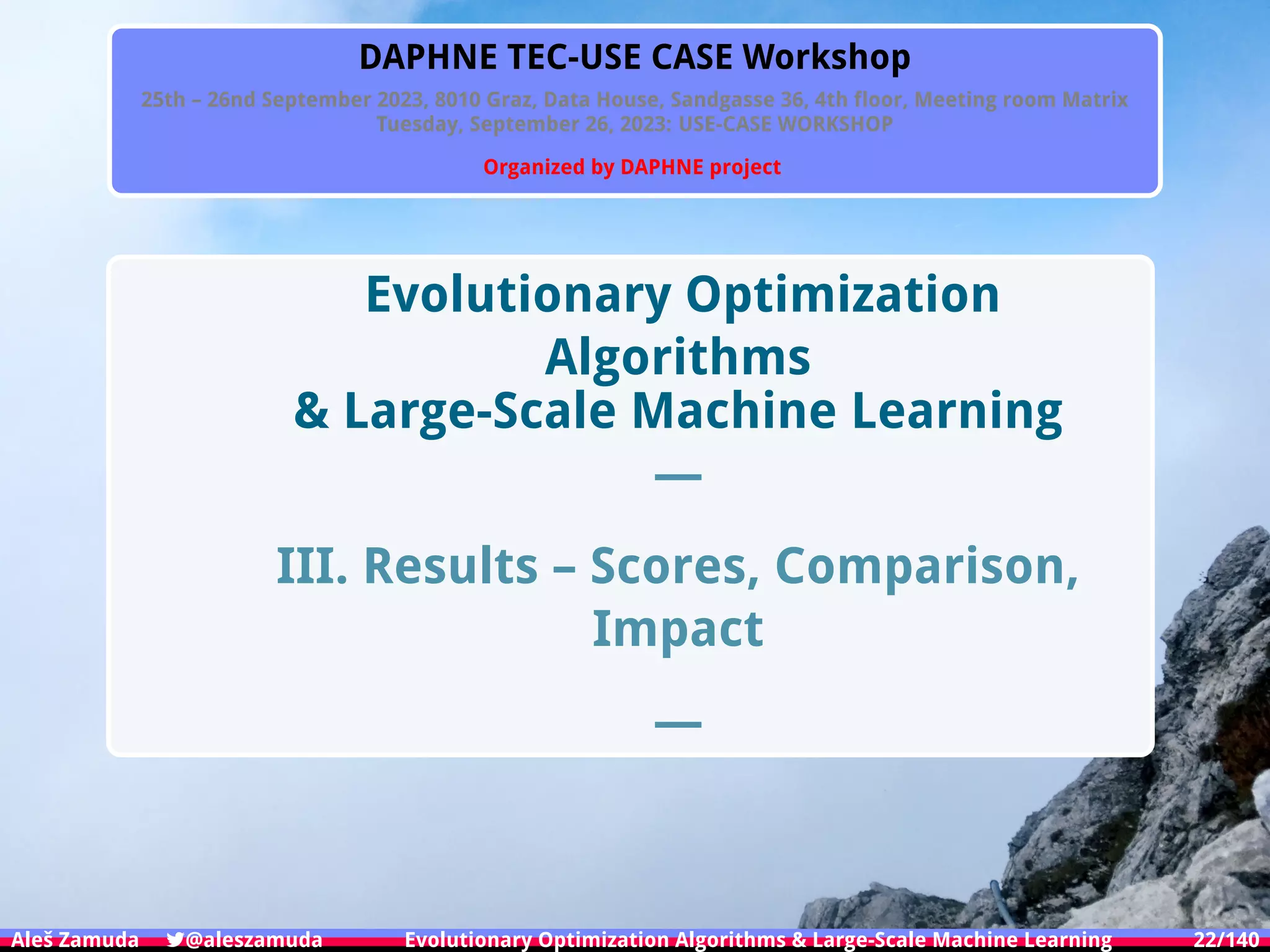


![Introduction Backgrounds DIFFERENTIAL EVOLUTION Method Results Conclusion Appendix
Score Obtained: 100
Fifty runs for each function sorted by the number of correct
digits (for DISHchain3e+12 algorithm)
Num. correct digits
No. Problem name X∗
D Search Range 0 1 2 3 4 5 6 7 8 9 10 Score
1 Storn’s Chebyshev Polynomial Fitting Problem 1 9 [-8192,8192] 0 0 0 0 0 0 0 0 0 0 50 10
2 Inverse Hilbert Matrix Problem 1 16 [-16384,16384] 0 0 0 0 0 0 0 0 0 0 50 10
3 Lennard-Jones Minimum Energy Cluster 1 18 [-4,4] 0 0 0 0 0 0 0 0 0 0 50 10
4 Rastrigin’s Function 1 10 [-100,100] 0 0 0 0 0 0 0 0 0 0 50 10
5 Griewangk’s Function 1 10 [-100,100] 0 0 0 0 0 0 0 0 0 0 50 10
6 Weierstrass Function 1 10 [-100,100] 0 0 0 0 0 0 0 0 0 0 50 10
7 Modified Schwefel’s Function 1 10 [-100,100] 0 0 0 0 0 0 0 0 0 0 50 10
8 Expanded Schaffer’s F6 Function 1 10 [-100,100] 0 0 0 0 0 0 0 0 0 0 50 10
9 Happy Cat Function 1 10 [-100,100] 0 0 0 0 0 3 5 1 6 1 34 10
10 Ackley Function 1 10 [-100,100] 0 0 0 0 0 0 0 0 0 0 50 10
Score (total):) 100
X∗
denotes an optimum (transformed to 1 for all functions).
Aleš Zamuda 7@aleszamuda Evolutionary Optimization Algorithms Large-Scale Machine Learning 25/140](https://image.slidesharecdn.com/aleszamudaevolutionaryoptimizationalgorithmslarge-scalemachinelearningdaphnetec-usecaseworkshop26sep-230927134548-f9f6ce39/75/Evolutionary-Optimization-Algorithms-Large-Scale-Machine-Learning-25-2048.jpg)
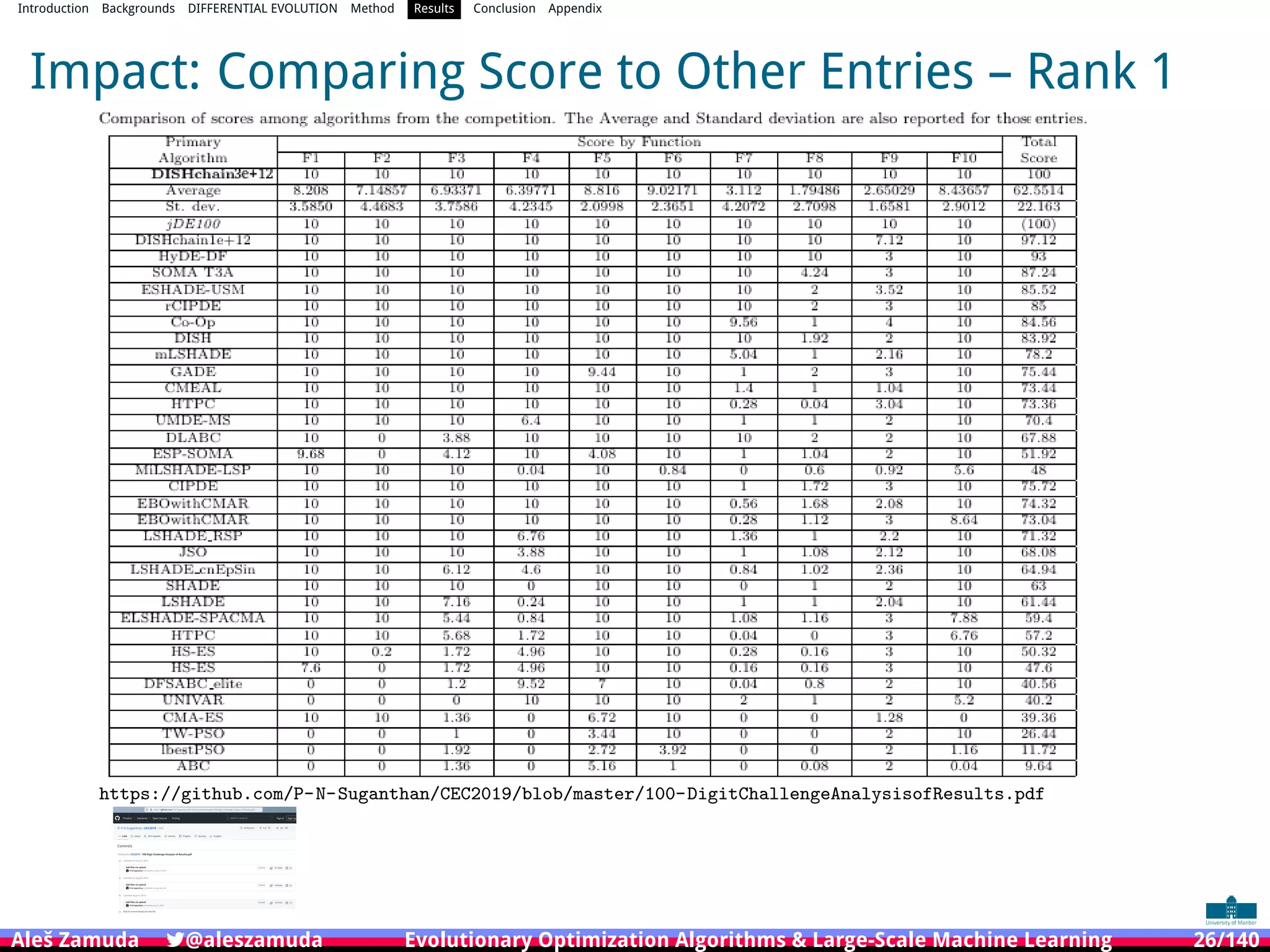
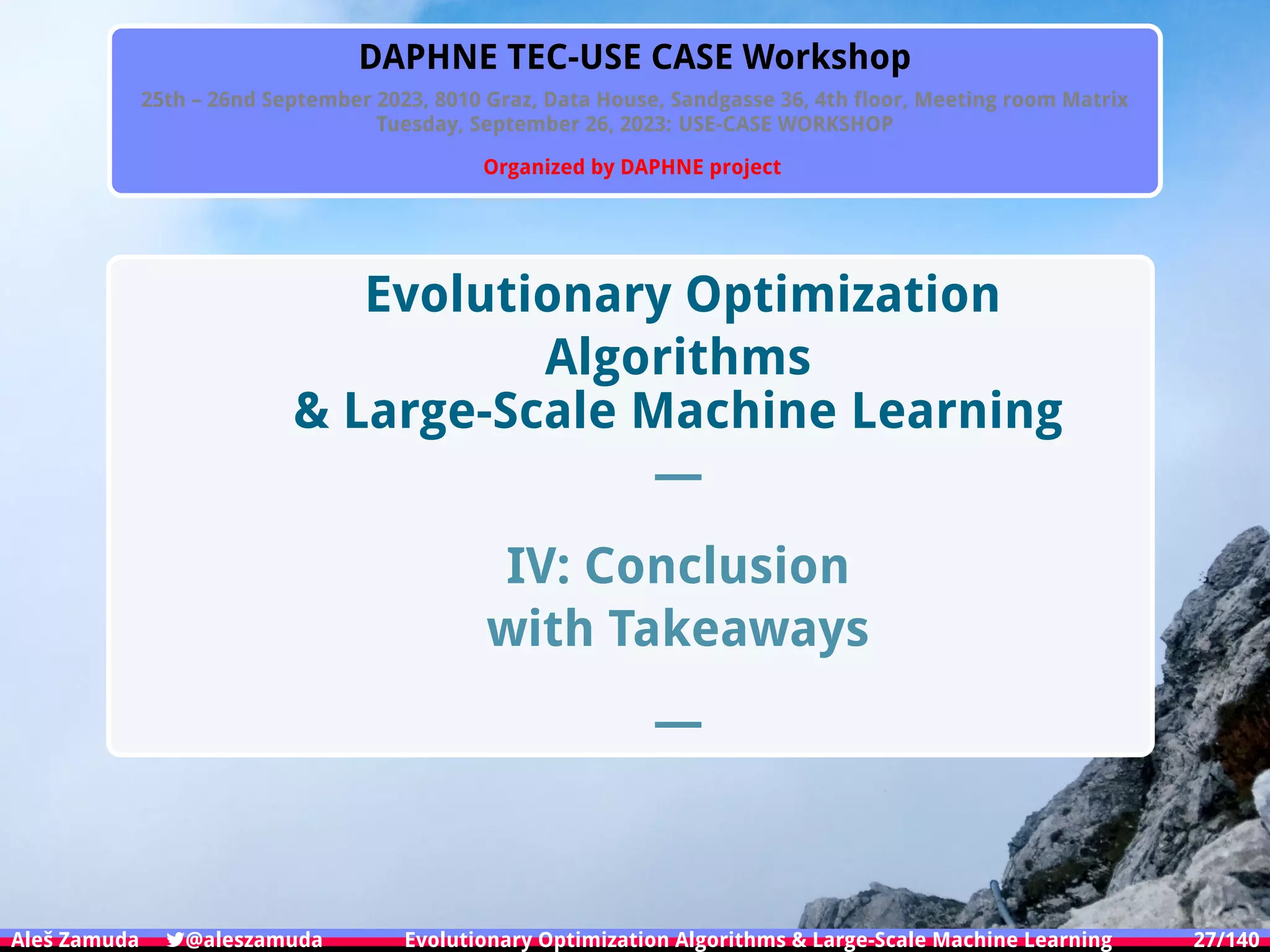
![Introduction Backgrounds DIFFERENTIAL EVOLUTION Method Results Conclusion Appendix
Conclusion with Takeaways
Conclusion: score of 100 (rank 1)
Takeaways: 100-digit Challenge; EAs; HPC a key element
Thanks!
Acknowledgement: this work is supported by DAPHNE, funded by the European
Union’s Horizon 2020 research and innovation programme under grant agreement
No 957407.
10000
1x106
1x108
1x1010
1x1012
0 1 2 3 4 5 6 7 8 9
FES
Digits
f1
f2
f3
f4
f5
f6
f7
f8
f9
f10
0 1 2 3 4 5 6 7 8 9
Combined power from 110 MW to 975 MW, step 0.01 MW#104
0
100
200
300
400
500
600
700
Individual
output
(power
[MW]
or
unit
total
cost
[$])
Cost, TC / 3
Powerplant P1 power
Powerplant P2 power
Powerplant P3 power
150
200
250
300
350
400
450
500
550
16 32 48 64 80
Seconds
to
compute
a
workload
Number of tasks (equals 16 times the SLURM --nodes parameter)
Summarizer workload
Real examples: science and HPC
Aleš Zamuda 7@aleszamuda Evolutionary Optimization Algorithms Large-Scale Machine Learning 28/140](https://image.slidesharecdn.com/aleszamudaevolutionaryoptimizationalgorithmslarge-scalemachinelearningdaphnetec-usecaseworkshop26sep-230927134548-f9f6ce39/75/Evolutionary-Optimization-Algorithms-Large-Scale-Machine-Learning-28-2048.jpg)





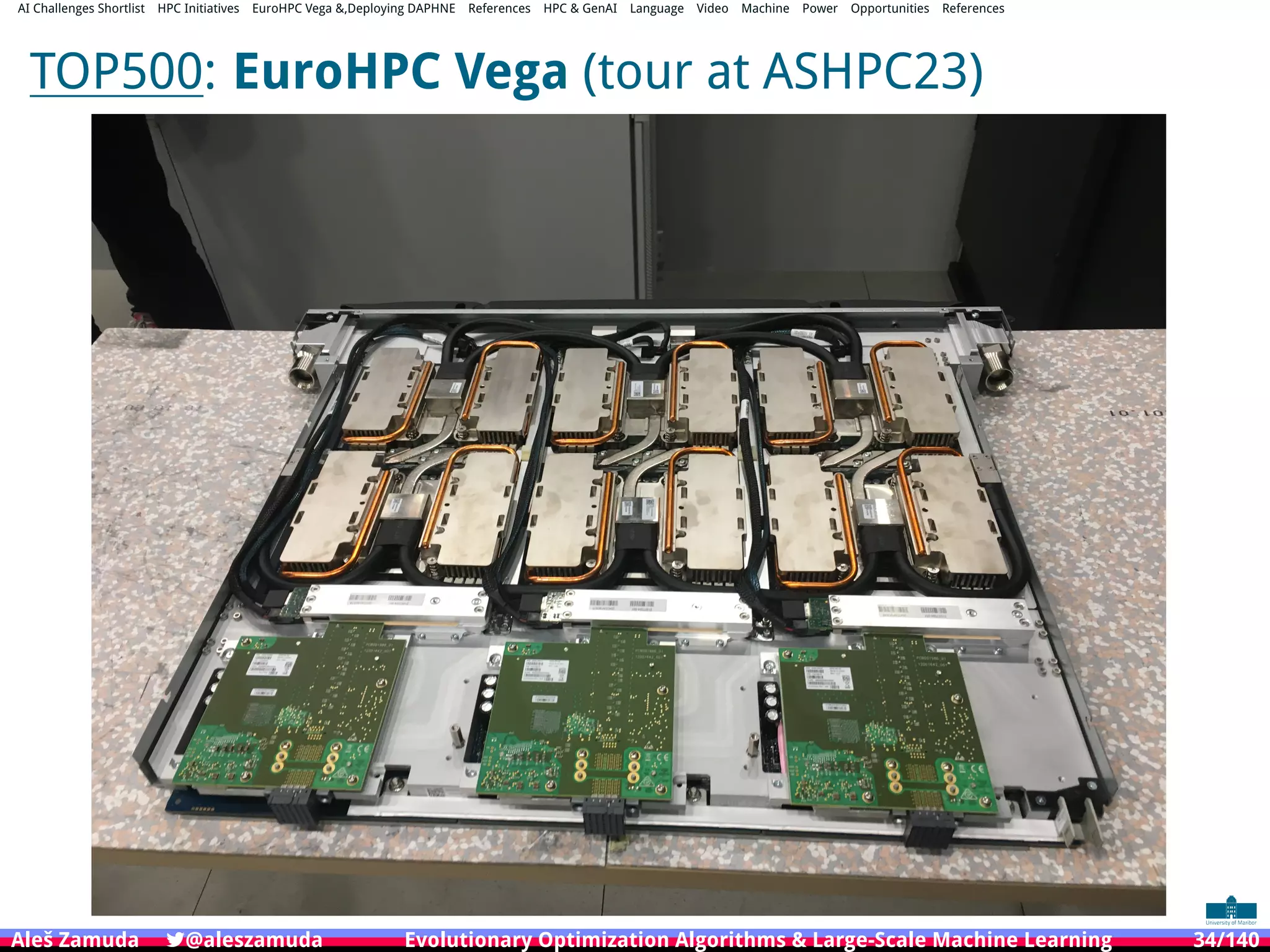

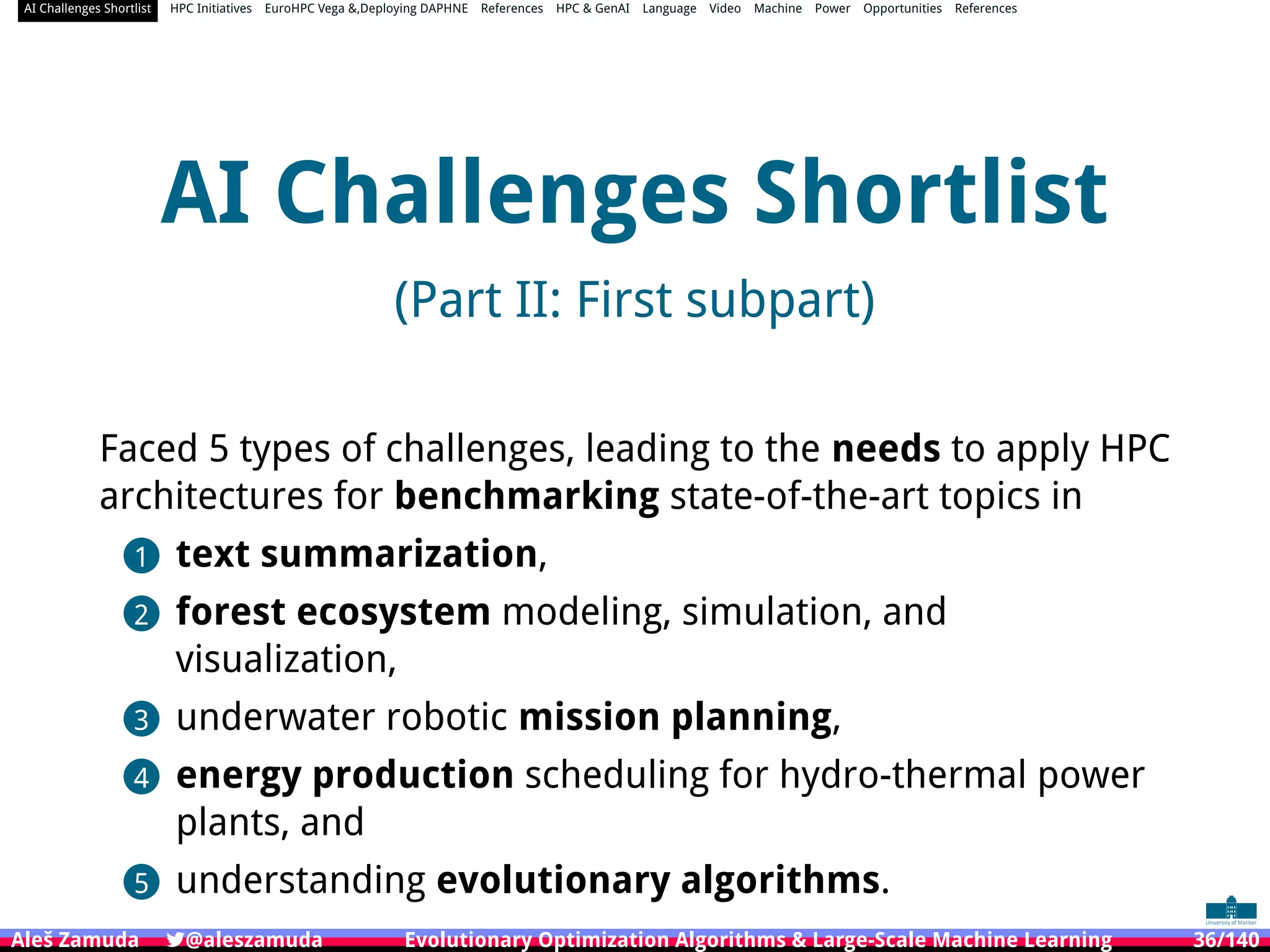
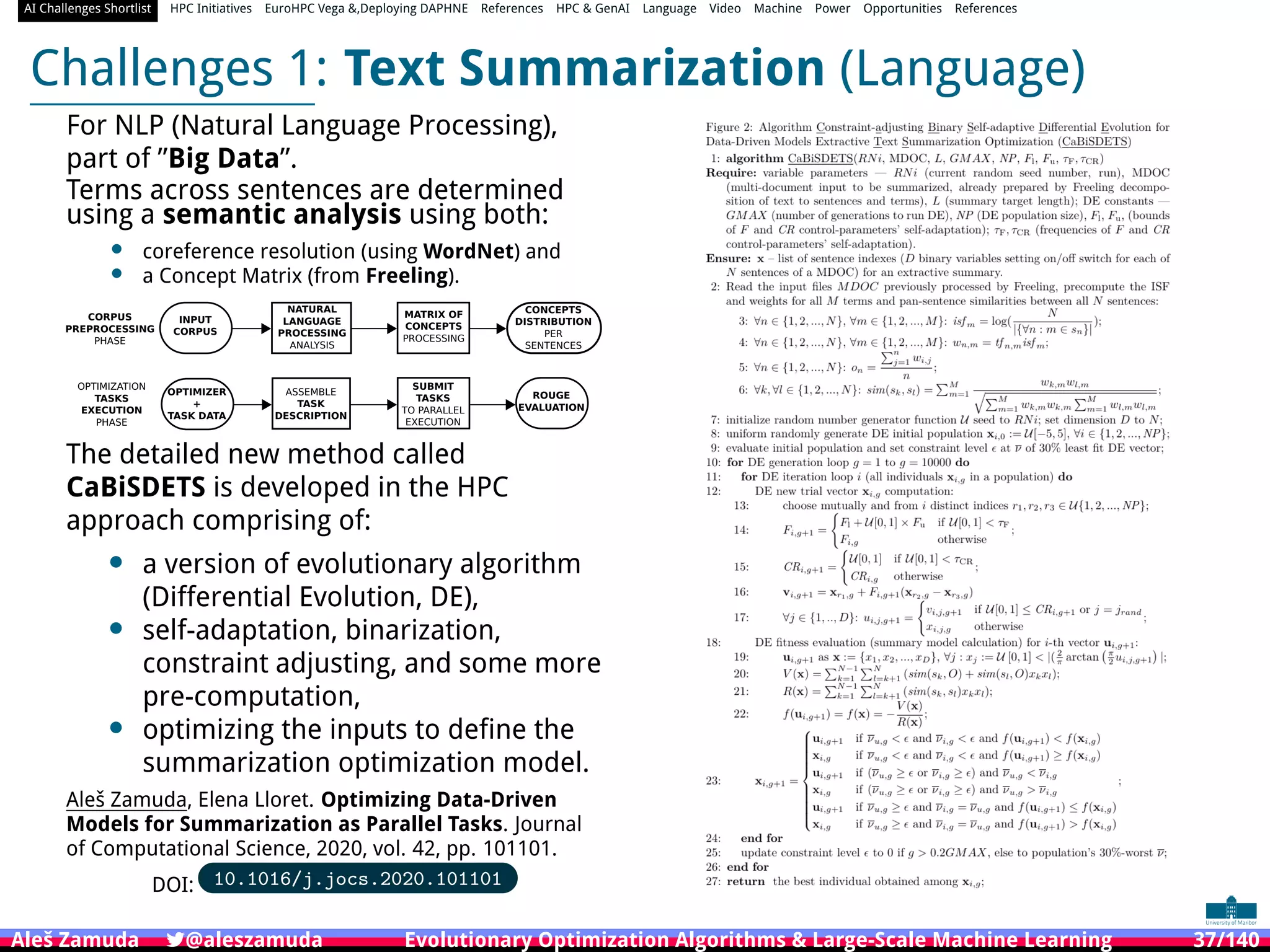
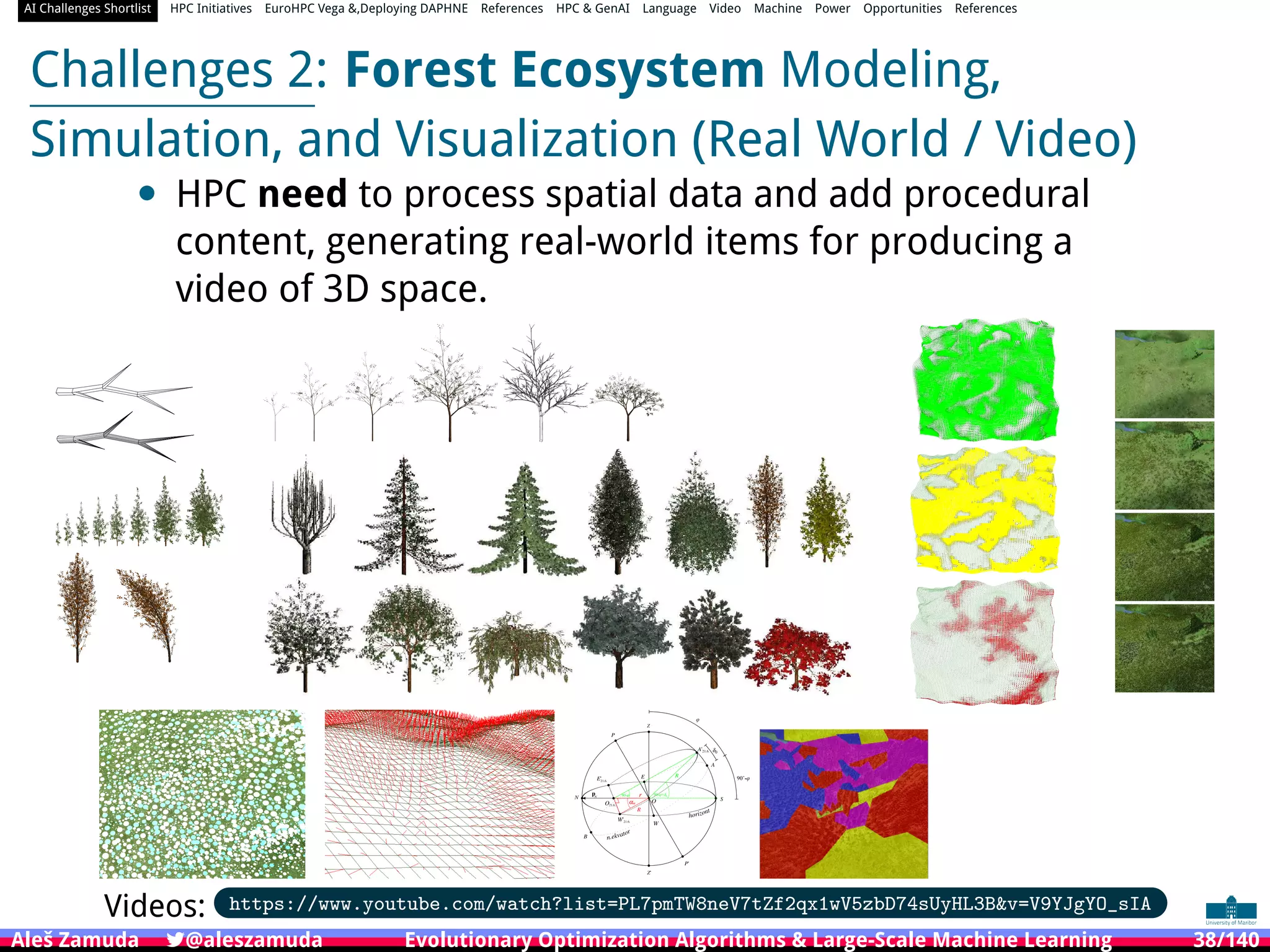
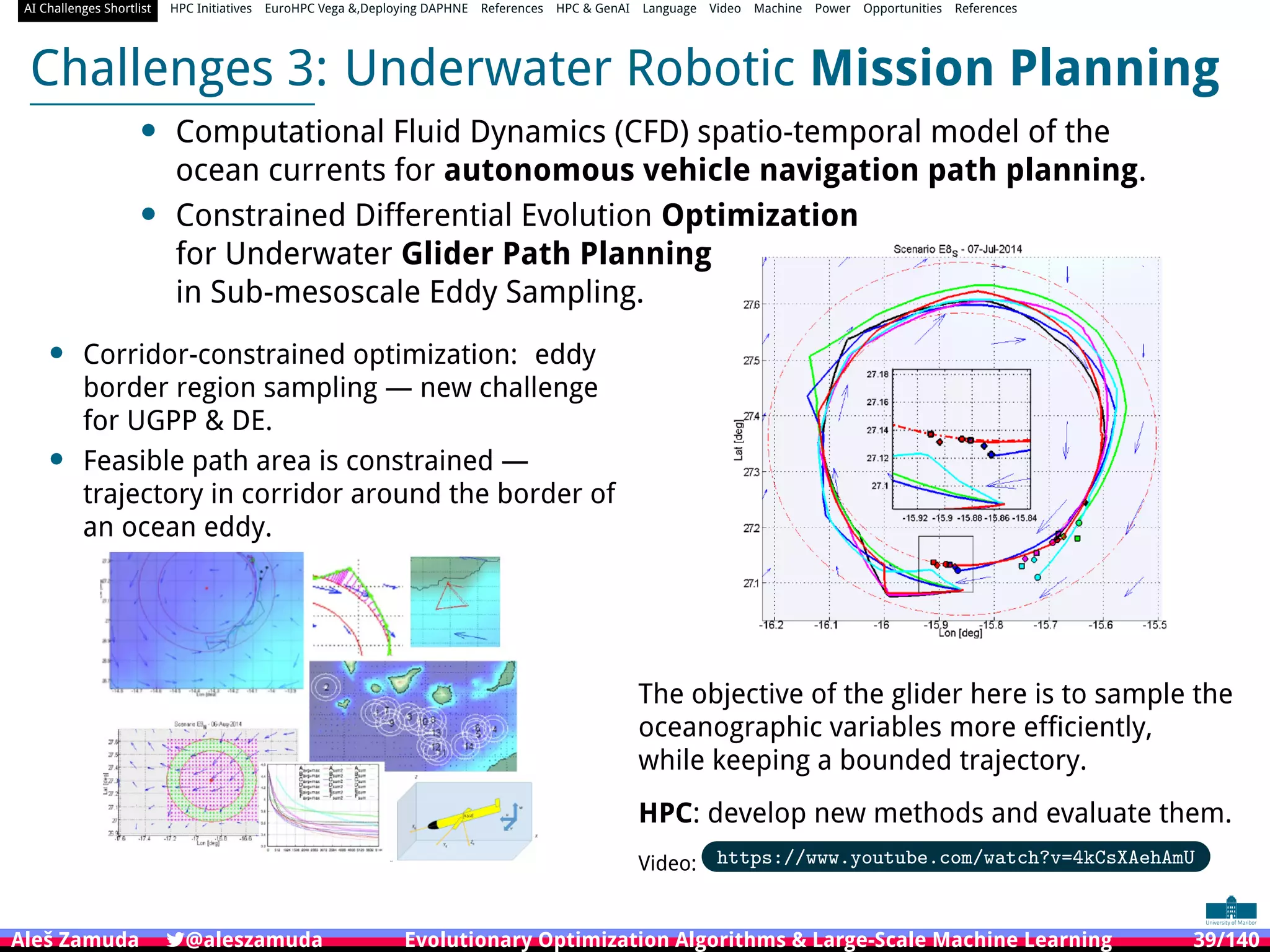

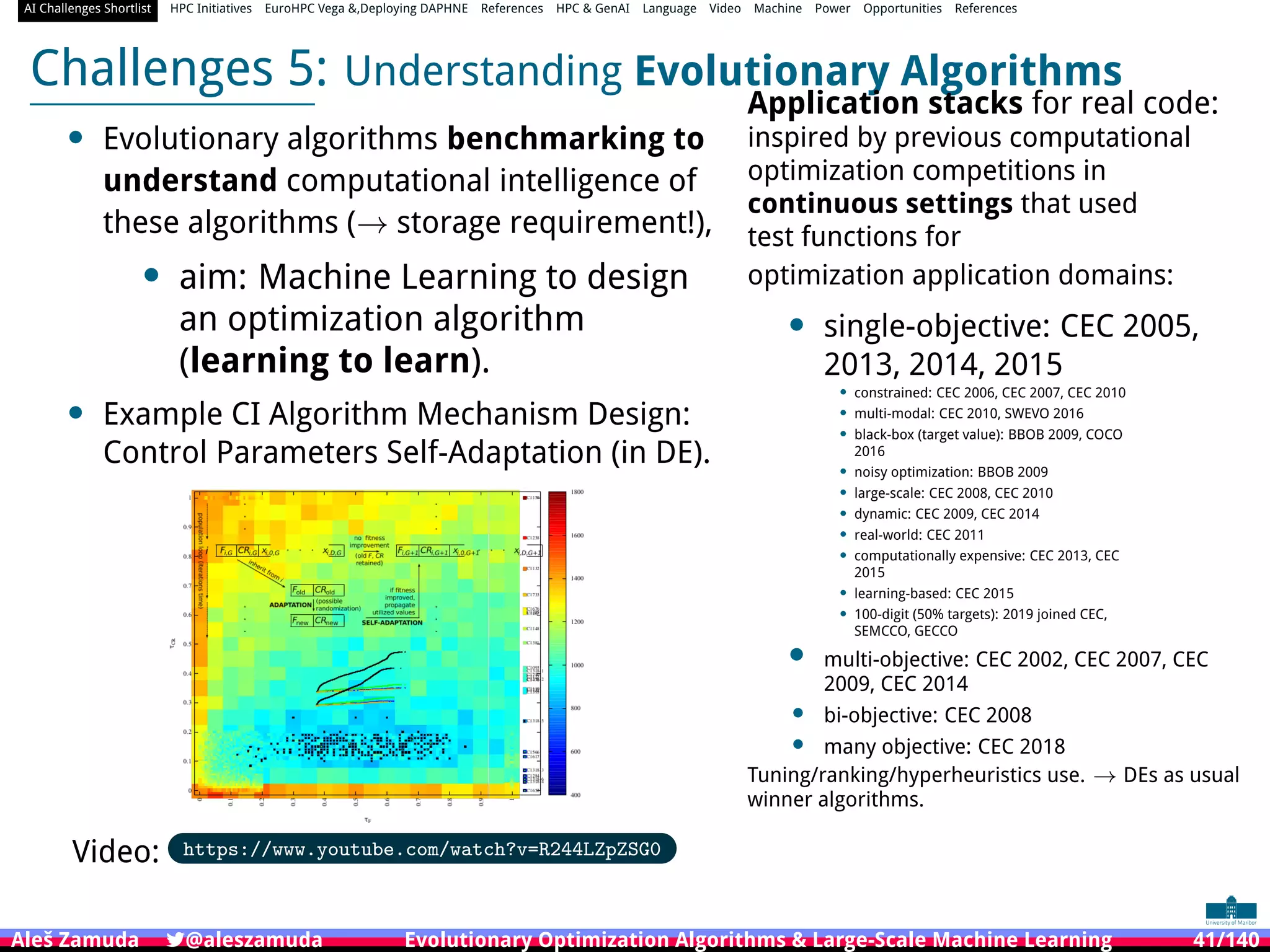
![AI Challenges Shortlist HPC Initiatives EuroHPC Vega ,Deploying DAPHNE References HPC GenAI Language Video Machine Power Opportunities References
Challenges 6: new DAPHNE Use Cases
Example Use Cases
• DLR Earth Observation
• ESA Sentinel-1/2 datasets 4PB/year
• Training of local climate zone classifiers on So2Sat LCZ42
(15 experts, 400K instances, 10 labels each, ~55GB HDF5)
• ML pipeline: preprocessing,
ResNet-20, climate models
• IFAT Semiconductor Ion Beam Tuning
• KAI Semiconductor Material Degradation
• AVL Vehicle Development Process (ejector geometries, KPIs)
• ML-assisted simulations, data cleaning, augmentation
• Cleaning during exploratory query processing
[So2Sat LC42: https://mediatum.ub.tum.de/1454690]
[Xiao Xiang Zhu et al: So2Sat LCZ42: A
Benchmark Dataset for the Classification of
Global Local Climate Zones. GRSM 8(3) 2020]
Aleš Zamuda 7@aleszamuda Evolutionary Optimization Algorithms Large-Scale Machine Learning 42/140](https://image.slidesharecdn.com/aleszamudaevolutionaryoptimizationalgorithmslarge-scalemachinelearningdaphnetec-usecaseworkshop26sep-230927134548-f9f6ce39/75/Evolutionary-Optimization-Algorithms-Large-Scale-Machine-Learning-42-2048.jpg)
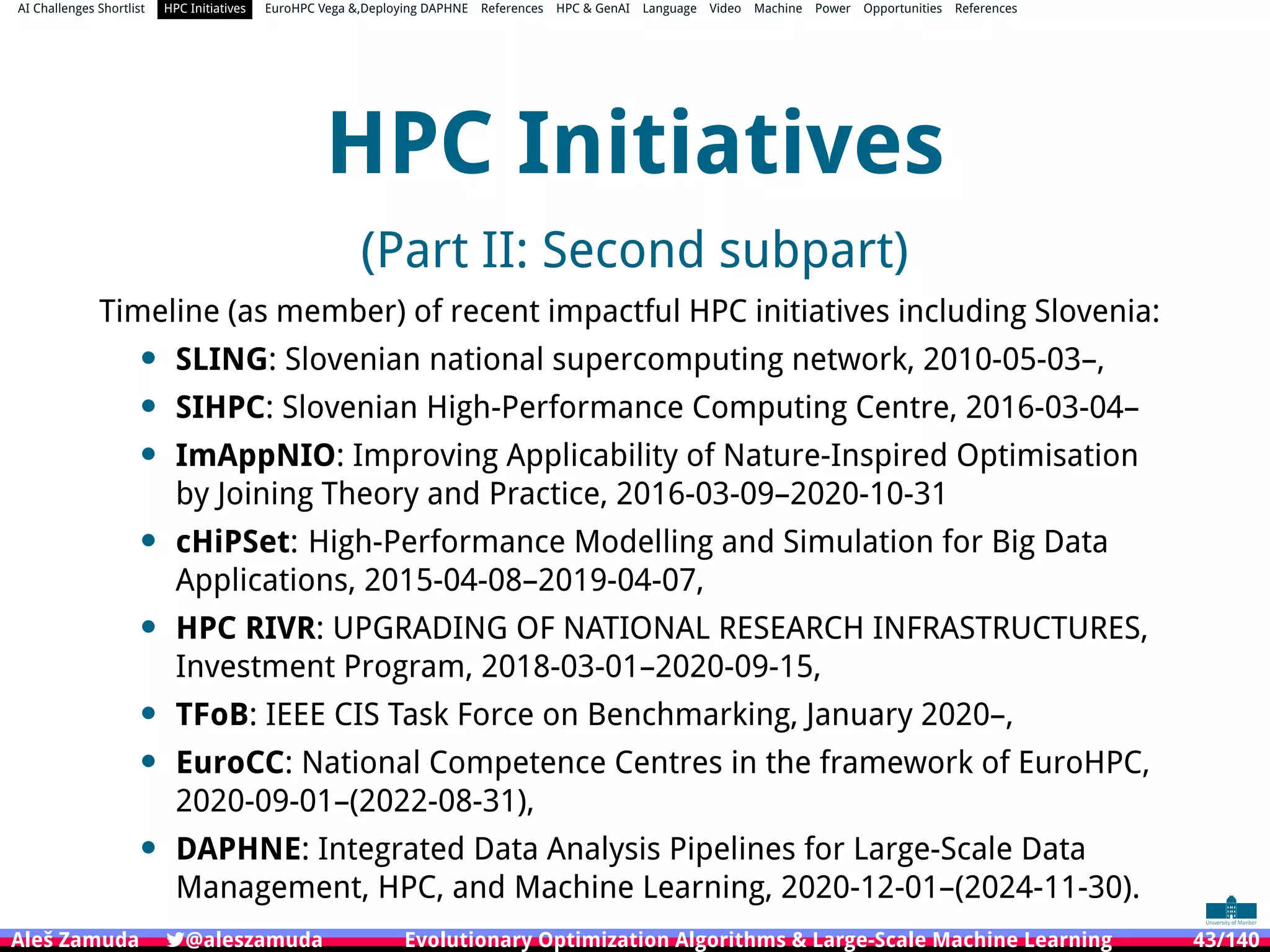

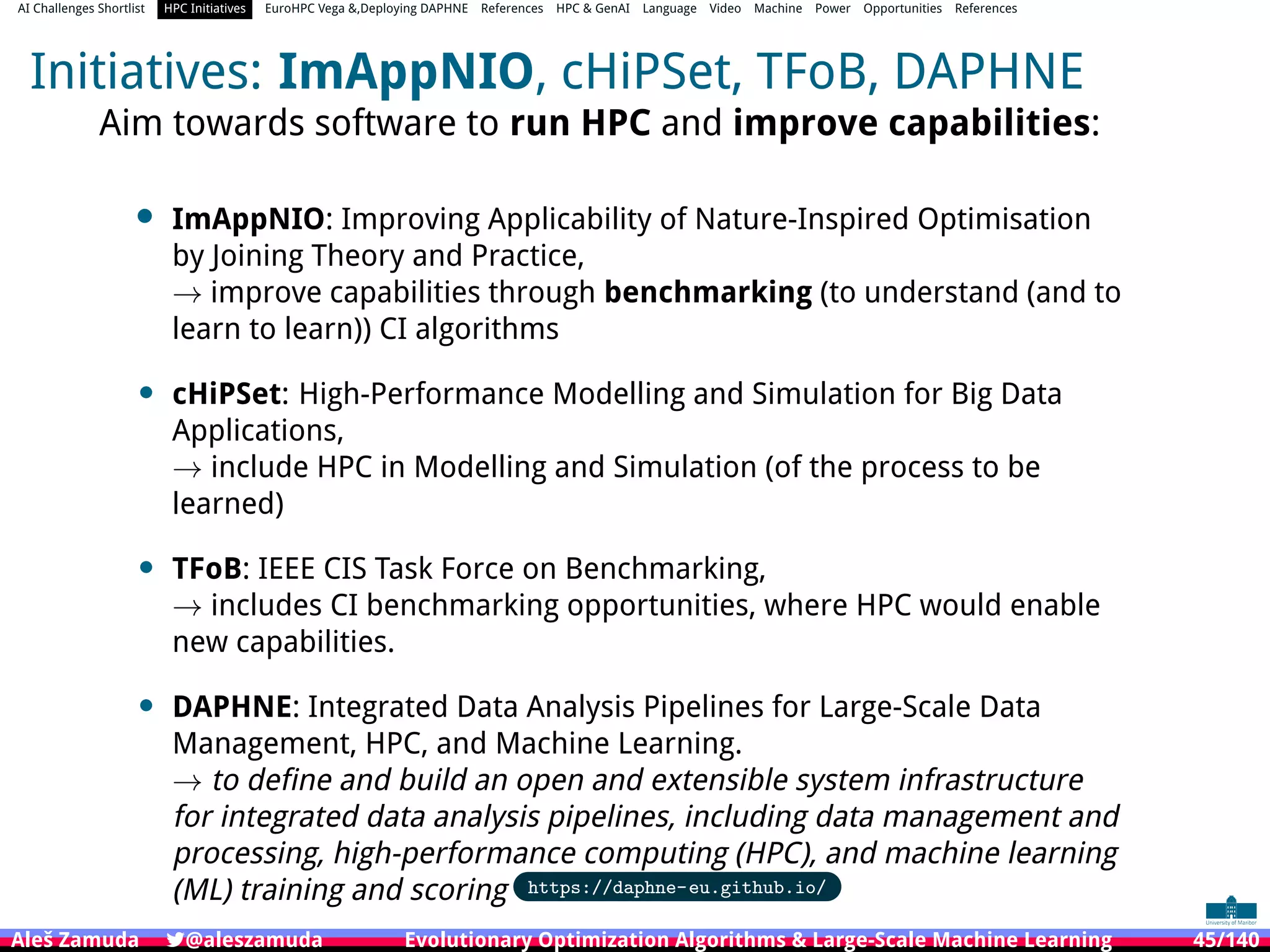
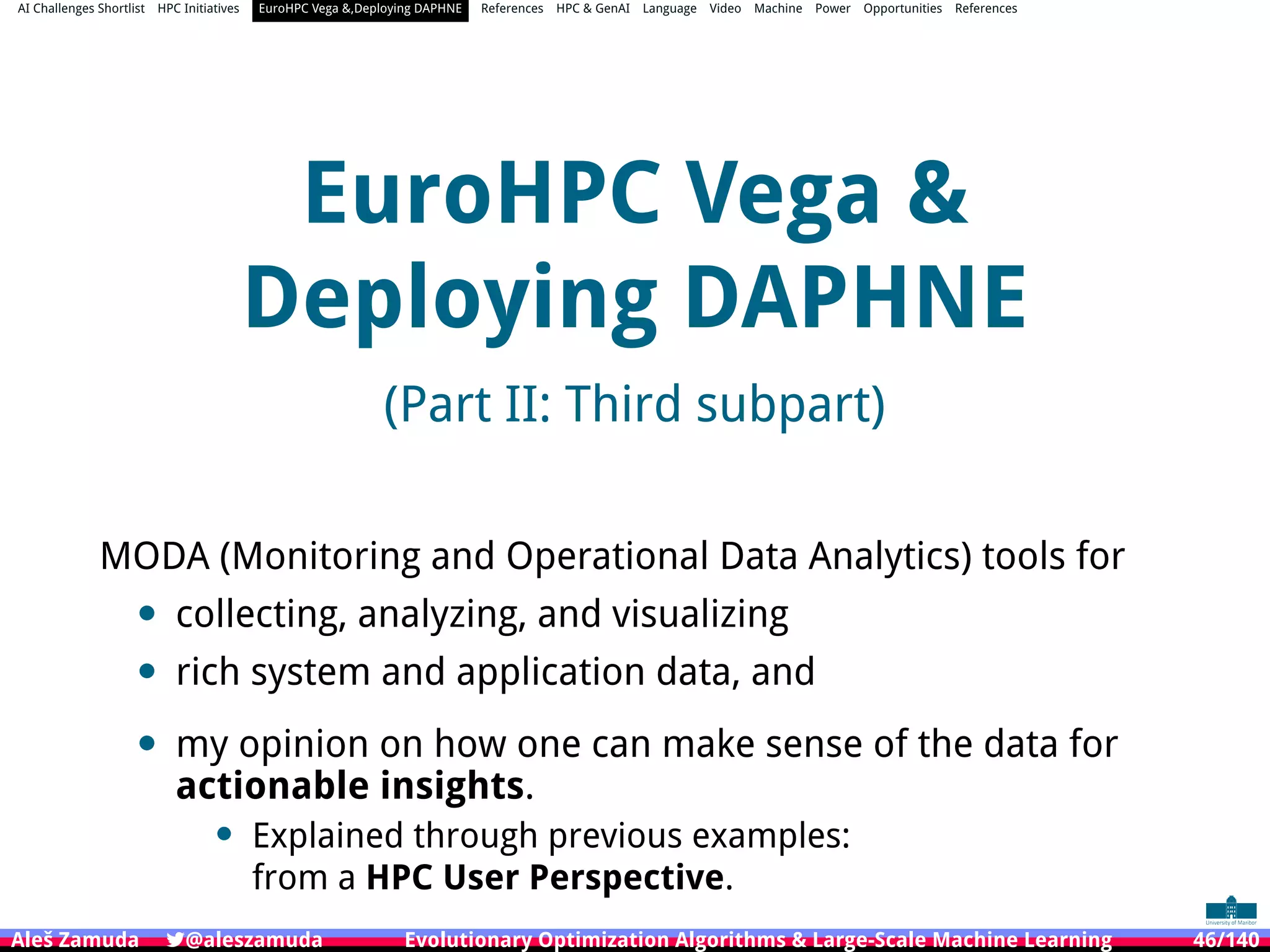


![AI Challenges Shortlist HPC Initiatives EuroHPC Vega ,Deploying DAPHNE References HPC GenAI Language Video Machine Power Opportunities References
Running the Tasks on HPC: ARC Job Submission,
Results Retrieval Merging [JoCS2020]
Through an HPC
approach and by
parallelization of tasks,
a data-driven
summarization model
optimization yields
improved benchmark
metric results (drawn
using gnuplot merge).
MODA is needed
to run again and
improve upon, to
forecast how to
set required task
running time and
resources
(predicting system
response).
Aleš Zamuda 7@aleszamuda Evolutionary Optimization Algorithms Large-Scale Machine Learning 49/140](https://image.slidesharecdn.com/aleszamudaevolutionaryoptimizationalgorithmslarge-scalemachinelearningdaphnetec-usecaseworkshop26sep-230927134548-f9f6ce39/75/Evolutionary-Optimization-Algorithms-Large-Scale-Machine-Learning-49-2048.jpg)


![AI Challenges Shortlist HPC Initiatives EuroHPC Vega ,Deploying DAPHNE References HPC GenAI Language Video Machine Power Opportunities References
EuroCC HPC: Vega (TOP500 #106, HPCG #56 — June 2021)
• Researchers apply to EuroHPC JU calls for access.
• Regular calls opened in 2021 fall (Benchmark Development).
• https://prace-ri.eu/benchmark-and-development-access-information-for-applicants/
• 60% capacities for national share (70% OA, 20% commercial, 10% host (community, urgent
priority of national importance, maintenance)) + 35% EuroHPC JU share (approved applications)
• Has a SLURM dev partition for SSH login (SLURM partitions w/ CPUs: login[0001-0004]=128;
login[0005-0008]=64; cn[0001-384,0577-0960]=256; cn[0385-0576]=256; gn[01-60]=256).
Listing 1: Setting up at Vega — slurm dev partition access (login).
1 [ ales . zamuda@vglogin0007 ˜]$ s i n g u l a r i t y pull qmake . s i f docker : / / ak352 /qmake−opencv
2 [ ales . zamuda@vglogin0007 ˜]$ s i n g u l a r i t y run qmake . s i f bash
3 cd sum; qmake ; make clean ; make
4
5 [ ales . zamuda@vglogin0007 ˜]$ cat runme . sh
6 # ! / bin / bash
7 cd sum time mpirun
8 −
−mca btl openib warn no device params found 0
9 . / summarizer
10 −
−useBinaryDEMPI −
−i n p u t f i l e mRNA−1273−t x t
11 −
−withoutStatementMarkersInput
12 −
−printPreprocessProgress calcInverseTermFrequencyndTermWeights
13 −
−printOptimizationBestInGeneration
14 −
−summarylength 600 −
−NP 200
15 −
−GMAX 400
16 summarizer . out . $SLURM PROCID
17 2 summarizer . err . $SLURM PROCID
Text summarization/generation systems
are getting more and more useful
and accessible on deployed systems
(e.g. OpenAI’s ChatGPT, Microsoft’s Bing AI part,
NVIDIA’s (Fin)Megatron, BLOOM,
LaMDA, BERT, VALL-E, Point-E, etc.). -0.65
-0.6
-0.55
-0.5
-0.45
-0.4
-0.35
-0.3
-0.25
-0.2
-0.15
-0.1
1 10 100
Evaluation
Aleš Zamuda 7@aleszamuda Evolutionary Optimization Algorithms Large-Scale Machine Learning 52/140](https://image.slidesharecdn.com/aleszamudaevolutionaryoptimizationalgorithmslarge-scalemachinelearningdaphnetec-usecaseworkshop26sep-230927134548-f9f6ce39/75/Evolutionary-Optimization-Algorithms-Large-Scale-Machine-Learning-52-2048.jpg)
![AI Challenges Shortlist HPC Initiatives EuroHPC Vega ,Deploying DAPHNE References HPC GenAI Language Video Machine Power Opportunities References
MODA at First EuroCC HPC Vega Supercomputer
Listing 2: Runnig at Vega MODA.
1 ===================================================================== GMAX=200 =====
2 [ ales . zamuda@vglogin0002 ˜]$ srun −
−cpu−bind=cores −
−nodes=1 −
−ntasks−per−node=101
3 −
−cpus−per−task=2 −
−
mem=180G s i n g u l a r i t y run qmake . s i f bash
4 srun : job 4531374 queued and waiting for resources
5 srun : job 4531374 has been allocated resources
6 [ ”$SLURM PROCID” = 0 ] . / runme . sh
7 real 5m22.475 s
8 user 484m42.262 s
9 sys 1m38.304 s
10 ===================================================================== NODES=51 =====
11 [ ales . zamuda@vglogin0002 ˜]$ srun −
−cpu−bind=cores −
−nodes=1 −
−ntasks−per−node=51
12 −
−cpus−per−task=2 −
−
mem=180G s i n g u l a r i t y run qmake . s i f bash
13 srun : job 4531746 queued and waiting for resources
14 srun : job 4531746 has been allocated resources
15 [ ”$SLURM PROCID” = 0 ] . / runme . sh
16 real 13m57.851 s
17 user 431m25.833 s
18 sys 0m29.272 s
19 ===================================================================== GMAX=400 =====
20 [ ales . zamuda@vglogin0002 ˜]$ srun −
−cpu−bind=cores −
−nodes=1 −
−ntasks−per−node=101
21 −
−cpus−per−task=2 −
−
mem=180G s i n g u l a r i t y run qmake . s i f bash
22 srun : job 4532697 queued and waiting for resources
23 srun : job 4532697 has been allocated resources
24 [ ”$SLURM PROCID” = 0 ] . / runme . sh
25 real 6m14.687 s
26 user 590m45.641 s
27 sys 1m40.930 s
Aleš Zamuda 7@aleszamuda Evolutionary Optimization Algorithms Large-Scale Machine Learning 53/140](https://image.slidesharecdn.com/aleszamudaevolutionaryoptimizationalgorithmslarge-scalemachinelearningdaphnetec-usecaseworkshop26sep-230927134548-f9f6ce39/75/Evolutionary-Optimization-Algorithms-Large-Scale-Machine-Learning-53-2048.jpg)
![AI Challenges Shortlist HPC Initiatives EuroHPC Vega ,Deploying DAPHNE References HPC GenAI Language Video Machine Power Opportunities References
More Output: SLURM accounting
Listing 3: Example accounting tool at Vega: sacct.
[ ales . zamuda@vglogin0002 ˜]$ sacct
4531374. ext+ extern vega−users 202 COMPLETED 0:0
4531746. ext+ extern vega−users 102 COMPLETED 0:0
4532697. ext+ extern vega−users 202 COMPLETED 0:0
[ ales . zamuda@vglogin0002 ˜]$ sacct −j 4531374 −j 4531746 −j 4532697
−o MaxRSS , MaxVMSize , AvePages
MaxRSS MaxVMSize AvePages
−
−
−
−
−
−
−
−
−
− −
−
−
−
−
−
−
−
−
− −
−
−
−
−
−
−
−
−
−
0 217052K 0
26403828K 1264384K 22
0 217052K 0
13325268K 1264380K 0
0 217052K 0
26404356K 1264384K 30
Future MODA testings:
• testing the web interface for job analysis (as available from HPC RIVR);
• profiling MPI inter-node communication;
• use profilers and monitoring tools available
— in the context of heterogeneous setups, like e.g.
• TAU Performance System — http://www.cs.uoregon.edu/research/tau/home.php,
• LIKWID Performance Tools — https://hpc.fau.de/research/tools/likwid/.
Aleš Zamuda 7@aleszamuda Evolutionary Optimization Algorithms Large-Scale Machine Learning 54/140](https://image.slidesharecdn.com/aleszamudaevolutionaryoptimizationalgorithmslarge-scalemachinelearningdaphnetec-usecaseworkshop26sep-230927134548-f9f6ce39/75/Evolutionary-Optimization-Algorithms-Large-Scale-Machine-Learning-54-2048.jpg)













![AI Challenges Shortlist HPC Initiatives EuroHPC Vega ,Deploying DAPHNE References HPC GenAI Language Video Machine Power Opportunities References
Generative AI — Some Background
• Early Learning to Learn, Google DeepMind after AlphaZero, deep RL algorithms
• https://gecco-2019.sigevo.org/index.html/Keynotes [@aleszamuda/status/1150672932588462081: ”Learning to learn ...”]
• Recent: with Reinforcement Learning (RL) trained Large Language Models (LLMs)
using Deep Neural Networks (DNNs) — Transformers (replacing RNN LSTMs; by Google —
2017, Attention Is All You Need: https://arxiv.org/abs/1706.03762, Submitted on 12 Jun 2017 (v1) — for NIPS’17 in December
(Jakob proposed replacing RNNs with self-attention and startedthe effort to evaluate this idea))
• A deployed LLM (Free Research
Preview of ChatGPT May 24
Version, 2023.) GPT-4 Technical Report:
https://arxiv.org/pdf/2303.08774.pdf
• Sample LLM code (Transformers by Hugging
Face), using Python3, AutoTokenizer, and
google/flan-t5-base
Transformers
architecture
Wikipedia (CC BY-SA
3.0), File:The-
Transformer-model-
architecture.png
• My GenAI backgrounds come from (evolutionary) generation of 3D scenery sequences (animation, AL — Artificial Life)
• In my 2020 journal article published with University of Alicante (w/ Elena Lloret), we
demonstrated HPC importance in NLP performance impact (Summarizer — developed on SLING)
• cites e.g. Salesforce Research’s NN paper on A Deep Reinforced Model for Abstractive Summarization, Submitted on 11 May
2017 (v1), https://arxiv.org/abs/1705.04304
Aleš Zamuda 7@aleszamuda Evolutionary Optimization Algorithms Large-Scale Machine Learning 68/140](https://image.slidesharecdn.com/aleszamudaevolutionaryoptimizationalgorithmslarge-scalemachinelearningdaphnetec-usecaseworkshop26sep-230927134548-f9f6ce39/75/Evolutionary-Optimization-Algorithms-Large-Scale-Machine-Learning-68-2048.jpg)

![AI Challenges Shortlist HPC Initiatives EuroHPC Vega ,Deploying DAPHNE References HPC GenAI Language Video Machine Power Opportunities References
HPC Application 1:
Text Summarization
• NLP and computational linguistics for Text Summarization:
• Multi-Document Text Summarization is a hard CI challenge.
• Basically, an evolutionary algorithm is applied for
summarization,
• it is a state-of-the-art topic of text summarization for NLP (part of
”Big Data”) and presented as a collaboration [JoCS2020],
acknowledging several efforts.
• we add: self-adaptation of optimization control parameters;
analysis through benchmarking using HPC, and
apply additional NLP tools.
• How it works: for the abstract, sentences from original text are
selected for full inclusion (extraction).
• To extract a combination of sentences:
• can be computationally demanding,
• we use heuristic optimization,
• the time to run optimization can be limited.
Aleš Zamuda 7@aleszamuda Evolutionary Optimization Algorithms Large-Scale Machine Learning 70/140](https://image.slidesharecdn.com/aleszamudaevolutionaryoptimizationalgorithmslarge-scalemachinelearningdaphnetec-usecaseworkshop26sep-230927134548-f9f6ce39/75/Evolutionary-Optimization-Algorithms-Large-Scale-Machine-Learning-70-2048.jpg)




![AI Challenges Shortlist HPC Initiatives EuroHPC Vega ,Deploying DAPHNE References HPC GenAI Language Video Machine Power Opportunities References
2 – Summary Optimization (3/3)
• d) Similarity between statements si = [wi,1, wi,2, ..., wi,m]
and sj = [wj,1, wj,2, ..., wj,m] is computed:
sim(si, sj) =
m
X
k=1
wi,kwj,k
qPm
k=1 wi,kwi,k
Pm
k=1 wj,kwj,k
,
where wi,k is term weight (defined in 5)) and m number of
all terms in text.
• e) When concluded:
• the selected statements from the best assessed
combination are printed,
• in order as they appear in the text, and
• the summary is stored.
Aleš Zamuda 7@aleszamuda Evolutionary Optimization Algorithms Large-Scale Machine Learning 75/140](https://image.slidesharecdn.com/aleszamudaevolutionaryoptimizationalgorithmslarge-scalemachinelearningdaphnetec-usecaseworkshop26sep-230927134548-f9f6ce39/75/Evolutionary-Optimization-Algorithms-Large-Scale-Machine-Learning-75-2048.jpg)

![AI Challenges Shortlist HPC Initiatives EuroHPC Vega ,Deploying DAPHNE References HPC GenAI Language Video Machine Power Opportunities References
Running the Tasks on HPC: ARC Job Preparation
Submission, Results Retrieval Merging [JoCS2020]
Through an HPC approach and by parallelization of tasks,
a data-driven summarization model optimization yields
improved benchmark metric results (drawn using gnuplot merge).
Aleš Zamuda 7@aleszamuda Evolutionary Optimization Algorithms Large-Scale Machine Learning 77/140](https://image.slidesharecdn.com/aleszamudaevolutionaryoptimizationalgorithmslarge-scalemachinelearningdaphnetec-usecaseworkshop26sep-230927134548-f9f6ce39/75/Evolutionary-Optimization-Algorithms-Large-Scale-Machine-Learning-77-2048.jpg)







![AI Challenges Shortlist HPC Initiatives EuroHPC Vega ,Deploying DAPHNE References HPC GenAI Language Video Machine Power Opportunities References
Ecosystem Afforestation: Terrain Models
• Tree models are put to terrain based on ecosystem
growth
pi,k =
xi yi,k zk
T
, i, k ∈ [0, 99].
• Power: fitness (height, slope, moisture, sunniness, windiness), age,
growth.
as,p = vs,phs,par;p, ar;p =
tf;s
max
s
{tf;s}
, vs,p =
ky;s,p + ms,p + ls,p + ws,p + ss,p
5
.
Aleš Zamuda 7@aleszamuda Evolutionary Optimization Algorithms Large-Scale Machine Learning 85/140](https://image.slidesharecdn.com/aleszamudaevolutionaryoptimizationalgorithmslarge-scalemachinelearningdaphnetec-usecaseworkshop26sep-230927134548-f9f6ce39/75/Evolutionary-Optimization-Algorithms-Large-Scale-Machine-Learning-85-2048.jpg)








![AI Challenges Shortlist HPC Initiatives EuroHPC Vega ,Deploying DAPHNE References HPC GenAI Language Video Machine Power Opportunities References
Basic Genotype Encoding
• An individual genotype vector x of a DE population
represents a set of procedural model parameters,
• by computing recursive procedure using a set of
parameters, EcoMod renders a tree (woody plant),
• dimensionality of the genotype x is D = 4509,
• where g ∈ {0, G = 15}, w ∈ {0, W = 50}, and
• each local G × W = 750 real-coded parameter encodes:
one matrix of a Gravelius and Weibull ordered parameter
for recursive calculations, and
• all xi,j ∈ [0, 1], i ∈ {1, 2, ..., NP} and j ∈ {1, 2, ..., D} are
linearly normalized by scaling in the [0,1] interval.
Aleš Zamuda 7@aleszamuda Evolutionary Optimization Algorithms Large-Scale Machine Learning 94/140](https://image.slidesharecdn.com/aleszamudaevolutionaryoptimizationalgorithmslarge-scalemachinelearningdaphnetec-usecaseworkshop26sep-230927134548-f9f6ce39/75/Evolutionary-Optimization-Algorithms-Large-Scale-Machine-Learning-94-2048.jpg)
![AI Challenges Shortlist HPC Initiatives EuroHPC Vega ,Deploying DAPHNE References HPC GenAI Language Video Machine Power Opportunities References
Bounds and Scaling of Genotype-encoded Parameters
xi,j
Parameter Formula Interval
Number of strands in a tree (tree com-
plexity)
S = 400xi,0 + 10 S ∈ [10, 410]
Height of base trunk l
0,0
0
= 10xi,1 l
0,0
0
∈ [0 m, 10 m]
Coefficient of branch thickness kd = 0.05xi,2 kd ∈ [0, 0.05]
Phyllotaxis angle αp = 360xi,3 αp ∈ [0◦
, 360◦
]
Branching ratio of subbranch strands
distribution
k
g,w
s = 0.5xi,j + 0.5, ∀j ∈ [4, 753] k
g,w
s ∈ [ 1
2
, 1]
Branching angle between dividing sub-
branches
αg,w
= 180xi,j ∀j ∈ [754, 1503] αg,w
∈ 0◦
, 180◦
Maximum relative sub-branch to base
branch length
Mg,w
= 20xi,j ∀j ∈ [1504, 2253] Mg,w
∈ [0, 20]
Minimum relative sub-branch to base
branch length
mg,w
= 20xi,j ∀j ∈ [2254, 3003] mg,w
∈ [0, 20]
Branch length scaling factor k
g,w
l
= 20xi,j, ∀j ∈ [3004, 3753] k
g,w
l
∈ [0, 20]
Gravicentralism impact kc = xi,3754 kc ∈ [0, 1]
Gravimorphism impact (i.e. gravitational
bending of branches)
α
g,w
m = 360xi,j − 180, ∀j ∈ [3755, 4504] α
g,w
m ∈ [−180◦
, 180◦
]
Enabling leaves display on a tree Bl = xi,4505 0.5?0 : 1 Bl ∈ {0, 1}
Size of leaves ll = 0.3xi,4506 ll ∈ [0, 0.3]
Density of leaves ρl = 30xi,4507 ρl ∈ [0, 30]
Leaf distribution type ltype = 5xi,4508 Spiral, Stacked, Stagg-
ered, Bunched, or Conif-
erous
Aleš Zamuda 7@aleszamuda Evolutionary Optimization Algorithms Large-Scale Machine Learning 95/140](https://image.slidesharecdn.com/aleszamudaevolutionaryoptimizationalgorithmslarge-scalemachinelearningdaphnetec-usecaseworkshop26sep-230927134548-f9f6ce39/75/Evolutionary-Optimization-Algorithms-Large-Scale-Machine-Learning-95-2048.jpg)



![AI Challenges Shortlist HPC Initiatives EuroHPC Vega ,Deploying DAPHNE References HPC GenAI Language Video Machine Power Opportunities References
1: procedure MO reconstruction(z∗)
Require: S0 - maximum number of strands in base branch; also, other default parameters for MOjDE and
EcoMod
Ensure: Pareto set of reconstructed parameterized procedural 3D woody plant models
2: uniform randomly generate DE initial population xi,0 ∈ [0, 1] for i = 1..NP;
3: for DE generation loop g (while FEs 10000) do
4: for DE iteration loop i (for all individuals xi,g of a population) do
5: DE individual xi,g creation (adaptation, mutation, crossover):
6: Fi,G+1 =
(
Fl + rand1 × Fu if rand2 τ1,
Fi,G otherwise
; CRi,G+1 =
(
rand3 if rand4 τ2,
CRi,G otherwise
;
8: vi,G+1 = xr1,G + Fi,G+1(xr2,G − xr3,G);
9: ui,j,G+1 =
(
vi,j,G+1 if rand(0, 1) ≤ CRi,G+1 or j = jrand
xi,j,G otherwise
;
10: DE fitness evaluation (genotype-phenotype mapping, rendering, and comparison):
11: z1 = g(ui,g, β1), z2 = g(ui,g, β2) {Execute Algorithm branchsegment twice}
12: h1(z1) =
P
x,y m1(z1
x,y, z∗
x,y) +
P
x,y m1(z∗
x,y, z1
x,y); {First difference metric, at 0◦
}
13: h1(z2) =
P
x,y m1(z2
x,y, z∗
x,y) +
P
x,y m1(z∗
x,y, z2
x,y); {First difference metric, at 90◦
}
14: f1(x) = f(g(x, β1), g(x, β2)) = h1(z1) + h1(z2); {Fitness evaluation, 1st criterion}
15: h2(z1) =
P
x,y w(z1
x,y, z∗
x,y) +
P
x,y w(z∗
x,y, z1
x,y); {Second difference metric, 0◦
}
16: h2(z2) =
P
x,y w(z2
x,y, z∗
x,y) +
P
x,y w(z∗
x,y, z2
x,y); {Second difference metric, 90◦
}
17: f2(x) = f(g(x, β1), g(x, β2)) = h2(z1) + h2(z2); {Fitness evaluation, 2nd criterion}
18: f(x) = {f1(x), f2(x)}; {Fitness evaluation, all criteria combined done}
19: DE selection:
20: xi,G+1 =
(
ui,G+1 if f(ui,G+1) ⪯ f(xi,G)
xi,G otherwise
; {Multi-objective comparison operator}
21: if not (ui,G+1 ⪯ xi,G or xi,G ⪯ ui,G+1 ) then add ui,G+1 to population archive;
22: end for
23: Truncate DE population archive to a size of NP using SPEA2 mechanism.
24: end for
25: return the best individuals obtained;
Aleš Zamuda 7@aleszamuda Evolutionary Optimization Algorithms Large-Scale Machine Learning 99/140](https://image.slidesharecdn.com/aleszamudaevolutionaryoptimizationalgorithmslarge-scalemachinelearningdaphnetec-usecaseworkshop26sep-230927134548-f9f6ce39/75/Evolutionary-Optimization-Algorithms-Large-Scale-Machine-Learning-99-2048.jpg)


![AI Challenges Shortlist HPC Initiatives EuroHPC Vega ,Deploying DAPHNE References HPC GenAI Language Video Machine Power Opportunities References
Tree Reconstruction: Summary Conclusions
• An approach to design woody plant geometrical models
[ASOC2011],
• rendered images are compared to the reference source
images, for reconstruction, to guide the optimization
process,
• sampled randomly to reconstruct geometrical models,
• procedural models are rendered using EcoMod
framework [INS2013],
• renderings of sample evolved models,
• parameters of the procedural model are iteratively
evolved using multi-objective differential evolution MOjDE
algorithm [CEC2012]
• fitness is evaluated by two criteria, which are not
pre-weighted,
• multi-objective optimization obtains multiple criteria
trade-offs shown using:
• attainment surfaces (trade-offs distribution), and
• rendered final approximation set models.
• The advanced approach [INS2014] adds
• real images preprocessing (tree trunk and crown
extraction),
• post-effects on reconstructed geometry (growth, wind,
leafs).
Aleš Zamuda 7@aleszamuda Evolutionary Optimization Algorithms Large-Scale Machine Learning 102/140](https://image.slidesharecdn.com/aleszamudaevolutionaryoptimizationalgorithmslarge-scalemachinelearningdaphnetec-usecaseworkshop26sep-230927134548-f9f6ce39/75/Evolutionary-Optimization-Algorithms-Large-Scale-Machine-Learning-102-2048.jpg)




























![AI Challenges Shortlist HPC Initiatives EuroHPC Vega ,Deploying DAPHNE References HPC GenAI Language Video Machine Power Opportunities References
HTS — HPC-deployable Results
• When generating energy plans,
• like load balancing schedules for energy power plants,
• data analytics and machine learning algorithm
can be used (PSADE@NPdynϵjDE [1]).
• Here, a surrogated [1] part of computation for the whole
problem is split non-trivially [1]
• and offloaded to an offline pre-computation phase.
• In this initial phase, an HPC can be used to generate a
lookup matrix, included as a surrogate matrix
during the next, online optimization phase.
• Experiment: an example set of 86500 long runs
(each 1 million fitness evaluations)
• to generate a surrogate matrix
with 0.01 MW granularity step
• for power demands
from 110 MW to 975 MW and 0.01 MW apart
• from 106
simulations for each of
86500 power demand scenarios.
0 1 2 3 4 5 6 7 8 9
Combined power from 110 MW to 975 MW, step 0.01 MW#104
0
100
200
300
400
500
600
700
Individual
output
(power
[MW]
or
unit
total
cost
[$])
Cost, TC / 3
Powerplant P1 power
Powerplant P2 power
Powerplant P3 power
[1] A. Glotić, A. Zamuda. Short-term combined economic and emission hydrothermal optimization by surrogate
differential evolution. Applied Energy, 1 March 2015, vol. 141, pp. 42-56. DOI 10.1016/j.apenergy.2014.12.020.
Aleš Zamuda 7@aleszamuda Evolutionary Optimization Algorithms Large-Scale Machine Learning 131/140](https://image.slidesharecdn.com/aleszamudaevolutionaryoptimizationalgorithmslarge-scalemachinelearningdaphnetec-usecaseworkshop26sep-230927134548-f9f6ce39/75/Evolutionary-Optimization-Algorithms-Large-Scale-Machine-Learning-131-2048.jpg)







![AI Challenges Shortlist HPC Initiatives EuroHPC Vega ,Deploying DAPHNE References HPC GenAI Language Video Machine Power Opportunities References
Takeaways
Takeaways: Generative AI scaling on HPC, Generative AI,
modalities (language, video, machines, power, sors)
Thanks!
Acknowledgement: this work is supported by DAPHNE, funded by the European
Union’s Horizon 2020 research and innovation programme under grant agreement
No 957407.
150
200
250
300
350
400
450
500
550
16 32 48 64 80
Seconds
to
compute
a
workload
Number of tasks (equals 16 times the SLURM --nodes parameter)
Summarizer workload
0 1 2 3 4 5 6 7 8 9
Combined power from 110 MW to 975 MW, step 0.01 MW#104
0
100
200
300
400
500
600
700
Individual
output
(power
[MW]
or
unit
total
cost
[$])
Cost, TC / 3
Powerplant P1 power
Powerplant P2 power
Powerplant P3 power
Real examples: science and HPC
Aleš Zamuda 7@aleszamuda Evolutionary Optimization Algorithms Large-Scale Machine Learning 139/140](https://image.slidesharecdn.com/aleszamudaevolutionaryoptimizationalgorithmslarge-scalemachinelearningdaphnetec-usecaseworkshop26sep-230927134548-f9f6ce39/75/Evolutionary-Optimization-Algorithms-Large-Scale-Machine-Learning-139-2048.jpg)